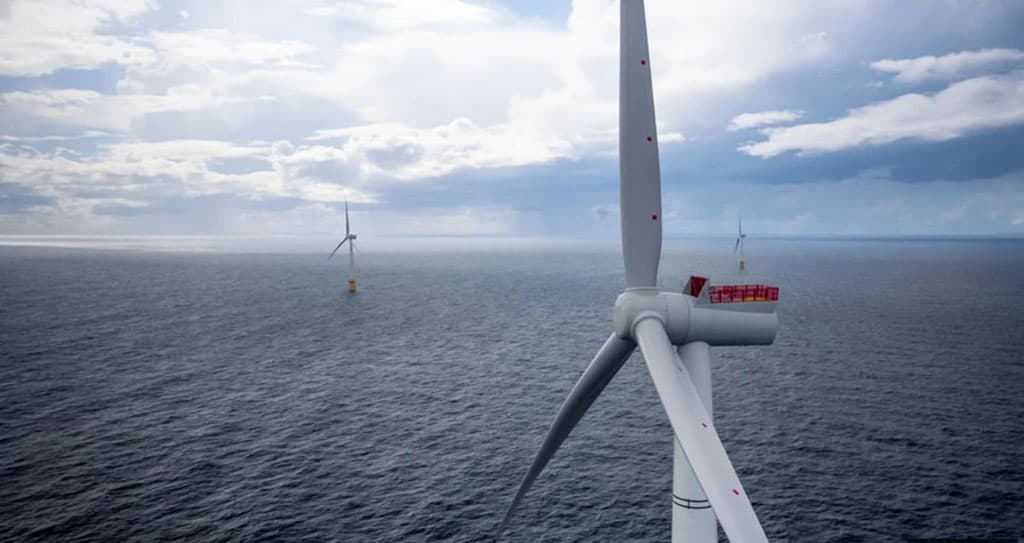News
Articles
Media
Posters
About Us
Contacts

 “Floating wind power has enormous potential to be a core technology for reaching the climate goals in Europe and around the world,” says Frank Adam, an expert on wind energy technology.
Some renewable energy experts remain skeptical that the high costs of floating offshore wind turbines will come down far enough to rival other clean-energy technologies. Currently the electricity they generate is often almost twice as expensive as near-shore wind turbines and three times that of land-based wind turbines.
But advocates of floating wind arrays note that the costs of onshore and near-shore wind energy have been steadily falling as the efficiency of these technologies has been rising. The same trends, they contend, are likely to lower the costs of floating offshore wind.
Walt Musial, an offshore wind energy expert, USA, says that in his country the coastal waters are often too deep for conventional offshore wind turbines. Nearly 60 percent of suitable offshore wind locations, he notes, exist in places at depths greater than 60 meter. That creates yet another opportunity for floating wind energy technologies.
Po Wen Cheng, head of an international research project on floating wind energy, says that floating turbines could produce more energy than the largest onshore or offshore technologies. Not only are winds in deeper waters more powerful than those closer to shore, he says, but the physics of the flexible, suspended rigs enables them to carry larger turbines. “The bigger the turbine, the more energy they can produce in the right conditions,” he says.
Cheng argues that floating turbines could be even taller than today’s largest offshore rigs, perhaps with 113-meter blades and towers stretching nearly 333 meter into the air. Turbines of such dimensions could generate three times the electricity of today’s most advanced onshore turbines, says Cheng. Like conventional offshore wind arrays, the floating turbines transmit electricity to coastal grid connections through heavy-duty underwater cables.
Offshore wind farms in the North Sea, Baltic Sea, and elsewhere have substantially increased clean-energy production in Europe and driven down the price to a level competitive with fossil fuels.
Investors and renewable energy companies say that the most formidable hurdle to full-scale rollout of floating wind arrays is recognition from governments, utilities, and financiers that the technology is viable and that costs will inevitably fall. Despite this, the technology of using open seas to produce renewable energy is sound.
“Floating wind power has enormous potential to be a core technology for reaching the climate goals in Europe and around the world,” says Frank Adam, an expert on wind energy technology.
Some renewable energy experts remain skeptical that the high costs of floating offshore wind turbines will come down far enough to rival other clean-energy technologies. Currently the electricity they generate is often almost twice as expensive as near-shore wind turbines and three times that of land-based wind turbines.
But advocates of floating wind arrays note that the costs of onshore and near-shore wind energy have been steadily falling as the efficiency of these technologies has been rising. The same trends, they contend, are likely to lower the costs of floating offshore wind.
Walt Musial, an offshore wind energy expert, USA, says that in his country the coastal waters are often too deep for conventional offshore wind turbines. Nearly 60 percent of suitable offshore wind locations, he notes, exist in places at depths greater than 60 meter. That creates yet another opportunity for floating wind energy technologies.
Po Wen Cheng, head of an international research project on floating wind energy, says that floating turbines could produce more energy than the largest onshore or offshore technologies. Not only are winds in deeper waters more powerful than those closer to shore, he says, but the physics of the flexible, suspended rigs enables them to carry larger turbines. “The bigger the turbine, the more energy they can produce in the right conditions,” he says.
Cheng argues that floating turbines could be even taller than today’s largest offshore rigs, perhaps with 113-meter blades and towers stretching nearly 333 meter into the air. Turbines of such dimensions could generate three times the electricity of today’s most advanced onshore turbines, says Cheng. Like conventional offshore wind arrays, the floating turbines transmit electricity to coastal grid connections through heavy-duty underwater cables.
Offshore wind farms in the North Sea, Baltic Sea, and elsewhere have substantially increased clean-energy production in Europe and driven down the price to a level competitive with fossil fuels.
Investors and renewable energy companies say that the most formidable hurdle to full-scale rollout of floating wind arrays is recognition from governments, utilities, and financiers that the technology is viable and that costs will inevitably fall. Despite this, the technology of using open seas to produce renewable energy is sound.
ORIENT news